

On April 8, 2006, a 38-year-old male volunteer fire fighter (the victim) was struck by a shackle on a recoiling tow rope and died three days later. The fire department was dispatched to a controlled burn that had escaped its boundaries. Fire fighters arrived on the scene, extinguished the fire, and started departing the scene. An engine was being driven out of a soybean field when it became stuck in the mud. An attempt was made to tow the engine from the field using a tractor, tow rope and screw-type shackles on either end of the tow rope attached to the tractor and engine. With the victim sitting in the driver’s seat of the engine and another fire fighter sitting in the passenger’s seat, a farmer started moving the tractor forward. When tension was applied to the tow rope, the shackle on the tractor failed and the tow rope with it’s shackle attached recoiled toward the engine. The shackle smashed through the windshield, struck the victim in the forehead and then proceeded out through the back window. Other fire fighters, standing in the area, witnessed the incident and ran to the aid of the victim and called for Emergency Medical Services (EMS). The victim was transported by ambulance to the local hospital and then was air lifted to a metropolitan trauma center. The victim died three days later on April 11, 2006, due to the injuries he sustained in the incident.
NIOSH investigators concluded that, to minimize the risk of similar occurrences, fire departments should:
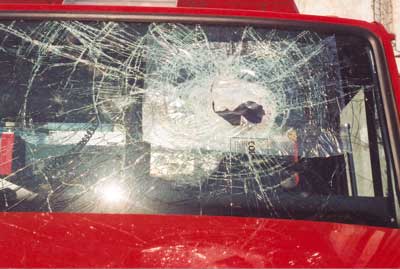 |
Windshield of the engine involved in incident |
On April 8, 2006, a 38-year-old male volunteer fire fighter (the victim) died after being struck by a shackle on a recoiling tow rope. On April 14, 2006, the U.S. Fire Administration notified the National Institute for Occupational Safety and Health (NIOSH) of this incident. On July 11-12, 2006, the Senior Investigator from the NIOSH Fire Fighter Fatality Investigation and Prevention Program investigated the incident. Meetings and interviews were conducted with the Chief of the department and the Deputy State Fire Marshal. The investigator reviewed the victim’s and officer-in-charge’s training records and death certificate. The department’s standard operating guidelines (SOGs), and the State Fire Marshal’s and County Sheriff’s Office incident reports were also reviewed. The apparatus, tow rope with one shackle, and incident site were photographed. (Note: The shackle attached to the tractor that failed during the incident had been lost prior to the investigator’s arrival and therefore was not available for assessment. There had been no photographs taken of the broken shackle).
Fire Department
This volunteer department consisted of 30 fire fighters that served a population of about 1,500 in a geographic area of approximately 135 square miles.
Training and Experience
The state does not require training for volunteer fire fighters. The victim did not have any formal fire fighter training, but had been in the fire service for 11 years and had been trained and certified as an emergency medical technician.
The Chief of the department and acting officer-in-charge at the incident scene had completed the state fire fighter certification I and II, and emergency medical technician training.
Apparatus involved in incident
Engine #34, 1999 model, 35,000 lbs gross vehicle weight rating(GVWR), equipped with a 1,250 gallon tank (Photo 1).
 |
Photo 1. Engine involved in incident.
(Photo courtesy of County Sheriff's office.) |
Incident Site
The incident site was a soybean stubble field with a slight incline. Wet spots existed in the low areas (Photo 2).
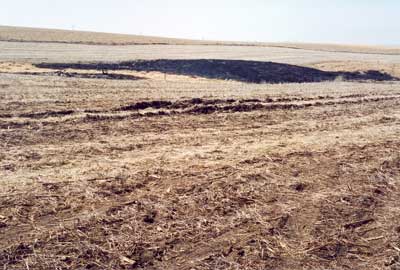 |
Photo 2. Incident site.
(Photo courtesy of County Sheriff's office.) |
Other Equipment involved in incident
Polyethylene tow rope, 27 ½’ long, 1 ½” diameter, rated to 37,500 lbs (Photo 3).
Farm tractor with small shackle (about 1/2 the size of the shackle attached to tow rope - witness account) attached to draw bar of tractor (Photo 4). Note: The broken shackle was lost prior to the investigators arrival, and the photo is a representation only.
Shackles (also known as Screw Pin Shackle and Farm Clevis), attached to either end of the tow rope with a working load limit (WLL) of 17,000 lbs (8 ½ tons) each (Photo 5).
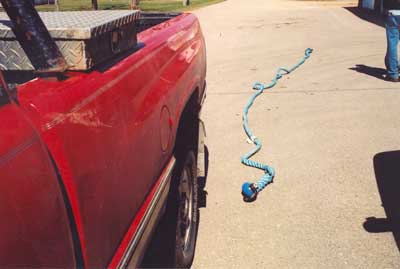 |
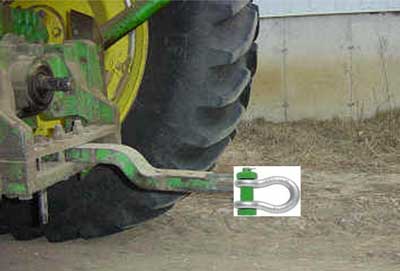 |
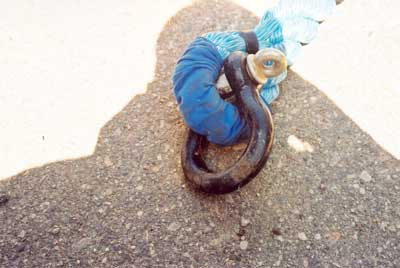 |
Photo 5. Screw pin shackle (also known as Farm Clevis). (Photo courtesy of County Sheriff's office.) |
Weather
The air temperature at the time of the incident was 65 degrees Fahrenheit with winds from the southeast at 10 miles per hour. The weather did not have any direct impact on the incident.
On April 8, 2006, at approximately 1509 hours, the fire department was dispatched to a controlled grass fire that had overrun its boundaries and was threatening the neighbor’s field. Several apparatus and personally owned vehicles responded and arrived on scene at about 1524 hours. The engine, which was the primary water source, was first on scene and had a full tank of water weighing about 10,375 lbs (1,250 gallon tank x 8.3 lbs/gallon = 10,375 lbs).
The engine was driven down into a soybean stubble field in proximity to the burning field and fire fighting activities commenced. After a short time, the fire was extinguished and fire fighters and apparatus started departing the scene. The engine, at that time with an approximate weight of 42,780 pounds (35,000 lbs GVWR of engine + about 7,780 lbs of water [3/4 tank of water]), was being driven out of the soybean field and became stuck in mud in a low, wet spot.
A farmer, who was watching the activities, saw that the engine had become stuck and offered to pull it out of the mud. The engine was emptied of water, and a fire department tow rope with shackles attached to either end was retrieved. Note: The tow rope was rated to 37,500 lbs, but the shackles were only rated to 8 ½ tons (17,000 lbs) capacity each
The shackle on one end of the rope was attached to a hook located on the front of the engine. The farmer attached the shackle on the other end of the tow rope to a smaller shackle already attached to the draw bar of his tractor. The farmer made several attempts to move forward and pull the engine free, but was unsuccessful. At that time, a second farmer brought his larger tractor to the scene. The small shackle and connections were removed from the smaller tractor and connected to the drawbar of the larger tractor.
The second farmer began to move the tractor forward, putting tension on the tow rope. Within seconds, the small shackle on the draw bar broke, and the tow rope, with its shackle still attached, recoiled toward the engine. The victim, who had driven the engine into the field, was sitting in the driver’s seat. Another fire fighter was sitting next to him in the passenger’s seat. The shackle, still attached to the end of the tow rope, crashed through the windshield, struck the victim on the forehead, and exited through the back window.
Fire fighters and other onlookers in the vicinity observed the incident and ran to aid the victim. Emergency Medical Services were called immediately, and fire fighters removed the victim from the engine and provided first aid. The victim was taken by ambulance to a local hospital and was subsequently taken by helicopter to a metropolitan trauma center. The victim died three days later from injuries sustained in the incident.
According to the Coroner’s office, the cause of death was blunt force head trauma.
Discussion: Heavy towing services are offered generally throughout the country and should be utilized to tow lodged or disabled apparatus. Heavy towing is accomplished with the use of specialized equipment such as, but not limited to, wire rope, winches, chocks, chains, air bags, and heavy duty towing vehicles. Personnel who perform heavy duty towing are specially trained and utilize appropriate equipment needed for the job. In this case, a polyethylene tow rope with shackles attached to either end was attached on one end to a smaller shackle on the draw bar of a farm tractor and on the other end, to a tow hook on the engine. When tension was applied to the tow rope, the shackle on the farm tractor failed, allowing the shackle and tow rope to recoil through the engine’s windshield and striking the victim on the forehead. Apparently, the capacity of the smaller shackle attached to the farm tractor was exceeded resulting in the incident occurring. The victim died of his injuries three days later. (Note: Following the incident, the fire department added a procedure to their SOGs which identifies the use of a heavy towing service for any future heavy towing needs. This procedure includes the name and telephone number of a heavy towing service available in the area).
Towing/pulling jobs are occasionally performed by fire departments using tow ropes, shackles, tow hooks and other rigging fixtures. Fire departments and fire fighters need to know equipment limitations and follow safety instructions supplied by the equipment manufacturer, such as the warning tag affixed to the tow rope and the working load limit stamped on the shackles. The warning tag on the tow rope used in this incident read – “When attaching the rope to a vehicle that is going to be pulled or to a vehicle that is to pull it, never attach the rope to a hook, clevis, chain, cable or other metal object that is weaker than the rated strength of this rope that is on the attachment.” In this case the engine had a gross vehicle weight rating of 35,000 lbs. The polyethylene tow rope used was rated to 37,500 lbs; however, the shackles (1” diameter) attached to the ends of the tow rope had a working load limit (WLL) of only 17,000 lbs each. Additionally, a smaller shackle attached to the draw bar of the tractor used in this incident, according to witness statements, appeared to be about half the size of the shackles attached to the tow rope, and its rating is assumed to be less than the 17,000 lb rating of the larger shackles. Theoretically, the shackle (1/2” diameter) on the draw bar could have had an approximate WLL of only 4,000 lbs. Once tension was applied to the tow rope with shackles attached, the undersized shackle on the draw bar of the tractor broke, allowing the tow rope and it’s shackle to recoil through the windshield, striking the victim.
When tow ropes/cables, chains, winches and associated hardware are used for pulling heavy objects, tension is applied to the object through the connecting tow ropes/cables, chains and hardware. This tensile force can be large, and when a component of the rigging hardware fails, the tensile force contained in the cable, chain and connecting hardware is suddenly released, propelling the broken components. SOGs and safe work practices should be developed and implemented to protect fire fighters from potential injury caused by the sudden release of energy. Hardware used for towing/pulling should only be used in accordance with the manufacturer's recommendations. In addition, tow ropes, chains, associated hardware such as shackles, cables, hooks, and straps should be examined for signs of wear or damage before each use. Cables should be inspected for frayed or broken strands, flat spots, kinks and other signs of damage. Hardware such as hooks, pulleys, shackles, etc., should be examined for cracks, bends, deformation, etc.
When rigging an object for towing/pulling, only appropriate sized connecting hardware should be used. Screw-pin type shackles (farm clevises) should be stamped with their safe working load limit (in tons) somewhere on the body of the clevis. For example, some common sizes and safe working limits for drop forged steel screw pin shackles are:1
3/8" 2,000 lbs or 1 Ton |
1 1/8” 18,500 lbs or 9.5 Tons |
|
|
|
|
|
|
|
|
|
|
Cables, chains and other hardware will have similar corresponding safe work load ratings. In this incident, the broken shackle could not be located, but, witness statements disclosed that the shackle that failed appeared to be "half the size" of the shackles (1” diameter) on the ends of the tow rope. Using the common sizes and safe working load limits provided above, the small shackle (1/2” diameter) may have had a capacity of around 4,000 lbs. Since the stuck vehicle had a gross vehicle weight of 35,000 pounds, all hardware used in the rigging should have been rated for a safe working load above this weight.
An option for reducing the hazard of whipping cables or flying objects is to place a coat, blanket, tarp or similar object over the tow rope or cable before applying tension. In the event that the cable or connecting hardware should break, the object on the cable will serve to weigh down the cable and reduce the possibility of the broken cable whipping or flying about.2-4 At least one manufacturer offers a commercial weight that is connected to the cable after all connections have been made and serves to hold down a broken cable to prevent the cable from whipping about.5 It is also good practice to raise the hood of the stuck vehicle to prevent the possibility of injury from flying objects. If at all possible, remove all passengers and the driver from the stuck vehicle before tightening the cable. Bystanders should stay as far away as possible and never downhill from vehicles being pulled uphill.2,4-5
Discussion: Fire fighters and other onlookers should be moved beyond the potential reach of recoiling cables or flying debris during towing/pulling operations. Being struck by a tow rope, shackle, or other rigging devices can and does cause injury and death. In this case, the victim was struck in the forehead by a shackle and he died three days later.
Discussion: Fighting wildland fire often requires that apparatus travel off the roadway to reach the fire. Weight, low ground clearance, and larger turning radius make some structural fire apparatus unsuited for off-road use. Even with apparatus specifically designed for off-road use, apparatus operators must know the capabilities and limitations of the apparatus they are operating and use them accordingly. Even on level terrain, an apparatus can become mired in soft ground, sand, or mud leaving it vulnerable to being overrun by a fire.6 In this case, the engine was not in danger of being overrun by fire because the fire had been contained, but the engine was driven into an area that was low and muddy and eventually became stuck in the mud. This situation resulted in the fire fighters trying to pull it out with the aid of a farmer’s tractor which ultimately led to a fire fighter’s death. Given the engine’s weight of 42,780 pounds (35,000 pounds GVWR + about 7,780 pounds of water [3/4 tank of water]), slope of field and wet low spots, perhaps the engine could have been positioned on higher, flatter ground and may not have become stuck in the mud.
Collier, B. [2006]. Rope, Cable, and Hardware.
http://www.e-rigging.com/store_products.cfm?Subcat_ID=268&Cat_ID=55&Menu_Choice=Catalog. Date accessed: May 22, 2007.
This incident was investigated by and the report written by Richard Braddee, Senior Investigator, Fire Fighter Fatality Investigation and Prevention Program, NIOSH, Division of Safety Research, Surveillance and Field Investigation Branch.
Mention of any company or product does not constitute endorsement by the National Institute for Occupational Safety and Health (NIOSH). In addition, citations to Web sites external to NIOSH do not constitute NIOSH endorsement of the sponsoring organizations or their programs or products. Furthermore, NIOSH is not responsible for the content of these Web sites.
Return to Fire Fighter Homepage
This page was last updated on 05/30/07.